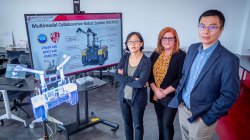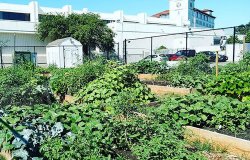Red Hawk Robot
National Science Foundation grant helps build robot system connecting research throughout campus
Posted in: Affiliated Research

Montclair State University research from Linguistics and Psychology to Biology and Mathematics, Earth Sciences, Chemistry, Business Analytics and more will be connected through a robot system being built with the help of a three-year, $289,737 grant from the National Science Foundation.
Weitian Wang, director of the University’s Collaborative Robotics and Smart Systems Laboratory, is principal investigator (PI) on the grant and working with co-PI Michelle Zhu, professor and the associate chair of the Department of Computer Science, and co-PI Amy Tuininga, director of the PSEG Institute for Sustainability Studies.
On paper, the impressive robot system may sound intimidating: “a multimodal collaborative robot system,” or MCROS, that will “advance a wide range of ongoing research projects sponsored by various agencies/organizations and foster multiple potential funding opportunities distributed across four colleges [College of Science and Mathematics, College of Humanities and Social Sciences, College of Education and Human Services and the Feliciano School of Business] and 12 academic units” covering “five focused areas: (1) intelligent systems and advanced computing, (2) ecology and chemistry sciences, (3) smart urban agriculture and food science, (4) human-factors engineering and social science, and (5) interactive learning.”
But the researchers say the robot system will also be somewhat … adorable.
Robots in the system will be short and squat, but agile, and run on omnidirectional wheels. Their appendages will be interchangeable. Sensors will make them smart and capable of learning.
The robot system will call the Center for Computing and Information Science home, where Wang says “other researchers can come to utilize the MCROS for indoor robot-related experiments.” Zhu explains that the robot system can also “be deployed in the field, in the wild. So it can help researchers to do some dangerous things.”
“It will be able to do anything from teaching a foreign language to sampling plants to see if they are ready to harvest,” says Tuininga. In fact, the robot system will shortly begin working with a vertical farm in Hackensack once some more parts are purchased.
Tuininga explains, “Our vertical farm partners are partnering with a program for adults with autism. We can use the language development component to work with people with disabilities at the same time as the plant sensing. Since it’s collaborative, the scientists and the adults with autism and the robot are all learning from each other.”
In addition, the robot system will aim to open up the STEM field to more students, especially female students and underrepresented minorities, with tangible and engaging hands-on projects in robot-supported courses and outreach programs.
Besides connecting multiple disciplines within the University, the system will ultimately connect the University nationwide to scholars, helping researchers at Montclair to launch robotics workshops with the state-of-the-art robotics knowledge and activities for local K-12 students, especially those from underserved districts, contributing to the development and diversity of the future high-tech workforce for New Jersey and the country.
But before the robot has its world debut next April or May, there is a lot of work to be done.
“Before you teach the MCROS, it’s just a machine,” says Wang. “The MCROS will learn from human demonstrations to make itself smarter just like a student will learn from teachers.”
Adds Zhu: “Anybody can buy the hardware, but then we also make the robot intelligent by developing different artificial intelligence software. With the software, the robot will be tailored to each different domain, each different problem.”
Tuininga says the project is “sharing the expertise of computer science with the whole University.”
“This is the beginning. It’s a gateway to allow many, many new possibilities for collaborations across campus and outside of campus for human and technology interaction.”
“Another feature is the uniqueness of our University,” says Wang. “We will have a lot of applications across subjects, from multiple colleges, multiple departments. The unique feature for our robot system is collaboration.”
Story by Staff Writer Mary Barr Mann. Photo by University Photographer Mike Peters.
